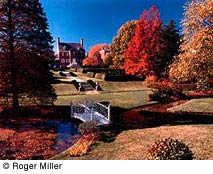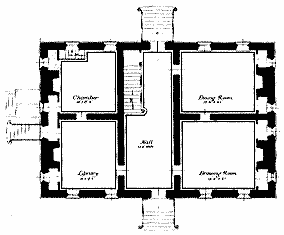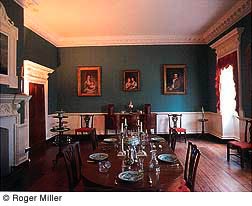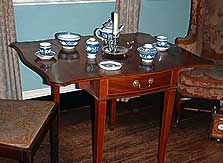|
The Georgian Style of British Colonial Annapolis The term Georgian refers to the historic period of all of the ruling King Georges of England and Ireland from 1714-1830. |
Intro 1 / Period Style 2 / Georgian History 3 / Shape 4 / Materials 5 / Structure 6 / Color 7 / Texture 8 / Size |
Although
the Georges did not influence the style per se, they perpetuated
a movement of Architecture that departed from the vogue Baroque
style prevalent in Catholic France and Italy. "Georgian
is a term usually associated in the popular mind with refined
furniture, elegant clothes, buildings of deceptive simplicity,
Classical music, decorous  prose,
and country houses set in pleasing parks." (Georgian Housestyle,
Ingrid Cranfield).
prose,
and country houses set in pleasing parks." (Georgian Housestyle,
Ingrid Cranfield).
For more on the History of the Georgian Style in Europe, see British Georgian Style History in Tools & Terms.
The Georgian Style in 18th Century British America
 The English Georgian style had
its counterparts in colonial America, although the chronology
and terminology differ slightly. The Palladian style first appears
at the turn of the 17th century in Williamsburg at the Wren Building
on the William and Mary campus, but the official Colonial American
Georgian style actually appears in the second decade of the 18th
century. The American Georgian style is the second phase of the
Colonial Architecture, and is associated with the emergence of
a wealthy middle class or "flowering of society" (The
Elements of style, pg. 106). The Georgian style officially ends
with American Independence, since the war caused a hiatus in
building and Americans wanted to
The English Georgian style had
its counterparts in colonial America, although the chronology
and terminology differ slightly. The Palladian style first appears
at the turn of the 17th century in Williamsburg at the Wren Building
on the William and Mary campus, but the official Colonial American
Georgian style actually appears in the second decade of the 18th
century. The American Georgian style is the second phase of the
Colonial Architecture, and is associated with the emergence of
a wealthy middle class or "flowering of society" (The
Elements of style, pg. 106). The Georgian style officially ends
with American Independence, since the war caused a hiatus in
building and Americans wanted to be
free of their associations with England. The next style to emerge
in this country is the American Federal style.
be
free of their associations with England. The next style to emerge
in this country is the American Federal style.
The
Georgian style was imported from England via pattern books, illustrations
and engravings. Initially the style was a symbol of prestige,
wealth and accomplishment. Only the wealthiest families could
afford to build homes of this stature, size and design. The limitations
of materials and skilled artisans contributed to the many interpretations
of the style.
Common architectural elements remained:
| Symmetrical
Shape Center Hall Axis Plan Classical Porticos Glass Fanlights Large Square Rooms |
Sash
Window Large Exterior Symmetrical Staircases A Center Hall Stairway Pediment Doorway Geometric Patterns of Glass Leading |
 Interior
Elements
Interior
Elements
The people who could afford to build a house of this style enjoyed a new enlightenment and needed to display their refinement as others did in grand style. In general, homes got bigger, more comfortable and more stylish than those built just a few decades before. The interior elements, material, colors and decorative arts of this theme varied much more regionally than did the architecture. For example, brick was used more for the Southern grand homes because the Negro slaves made this material from scratch. Bricks were very expensive to buy. Wood was the most common home building material in New England.
Many of the planters and merchants in the Southern region and particularly in Virginia and Maryland borrowed the five-part composition for their Georgian homes.
Eating, drinking, playing cards and dancing was serious business. Showing worldly possessions and manners were essential to acceptance in that social stratum. We have already mentioned that the central hall axis is important to the design. It was also important to the function of the house. It meant that guests could easily flow from room to room, depending on the activity. New rooms were developed to house new activities.
 The pursuit of classical learning
was important; therefore we see an emergence of a library room,
to display the conquest of learning (even if the books were blank
or just dummy covers). All of the frivolity the colonists copied
from their British counterparts also required the accouterments
necessary to stage this life. Just as in England, Americans needed
the new sideboards to present their wine coolers, plate racks,
and cutlery - all necessary for a pleasurable feast. A larger
dining room table was developed with many leaves to accommodate
the dining of "polite society". Comfortable dining
room chairs were created as dinners became long, drawn out affairs.
Foods from around the world were more accessible as global trading
bought in an unprecedented new amount of cuisine choices. The
tea table was invented for the serious matter of enjoying and
consuming one's tea. Just think of the teapots, kettles, and
other accessories that were needed to make a show of the tea
experience. After all, tea was very expensive, and sometimes
the ceremony could disguise the fact that there just wasn't much
tea around.
The pursuit of classical learning
was important; therefore we see an emergence of a library room,
to display the conquest of learning (even if the books were blank
or just dummy covers). All of the frivolity the colonists copied
from their British counterparts also required the accouterments
necessary to stage this life. Just as in England, Americans needed
the new sideboards to present their wine coolers, plate racks,
and cutlery - all necessary for a pleasurable feast. A larger
dining room table was developed with many leaves to accommodate
the dining of "polite society". Comfortable dining
room chairs were created as dinners became long, drawn out affairs.
Foods from around the world were more accessible as global trading
bought in an unprecedented new amount of cuisine choices. The
tea table was invented for the serious matter of enjoying and
consuming one's tea. Just think of the teapots, kettles, and
other accessories that were needed to make a show of the tea
experience. After all, tea was very expensive, and sometimes
the ceremony could disguise the fact that there just wasn't much
tea around.
All of this drinking, eating, learning and sharing seemed to fuel ideas of independence. Or was it just a tax relief plan these gentlemen sought as they looked to protect their increasing wealth?
The
Georgian style is probably the most admired, most collected and
most imitated of all period styles. So much is written about
it and there is still so much to see. We'll look at the forms
and characteristics of the style through a visual tour of Annapolis.
Previous / Intro /
1 / 2 / 3 / 4 /
5 / 6 /
7 / 8 /Next
Subscribe to our free and extremely informational newsletter. We would love to have your comments at: mail@designintuit.com
Welcome / What We're About / Focus on Annapolis / Marco Polo's Quest / Michelangelo's Den / Great Sites & Sources / Reading / Tiles & Textures / Tools & Terms / Contact Us
This site design and text © DesignIntuit, 2001